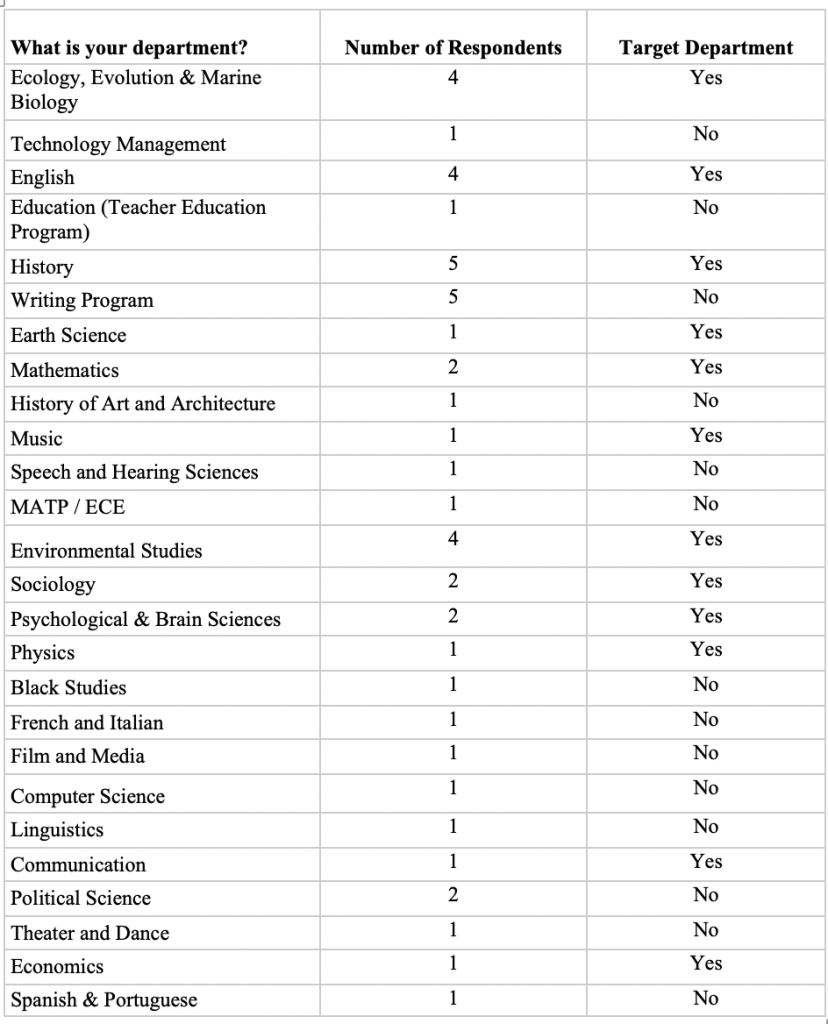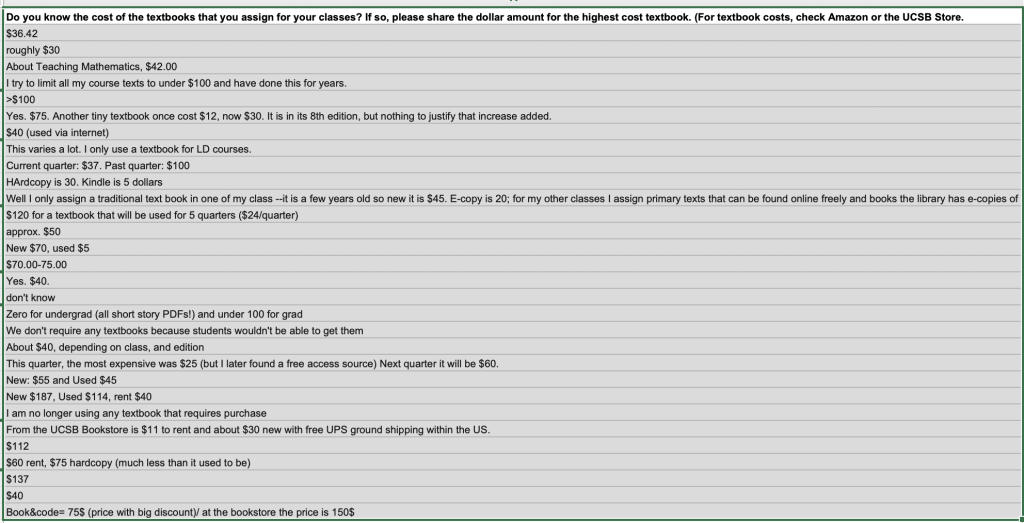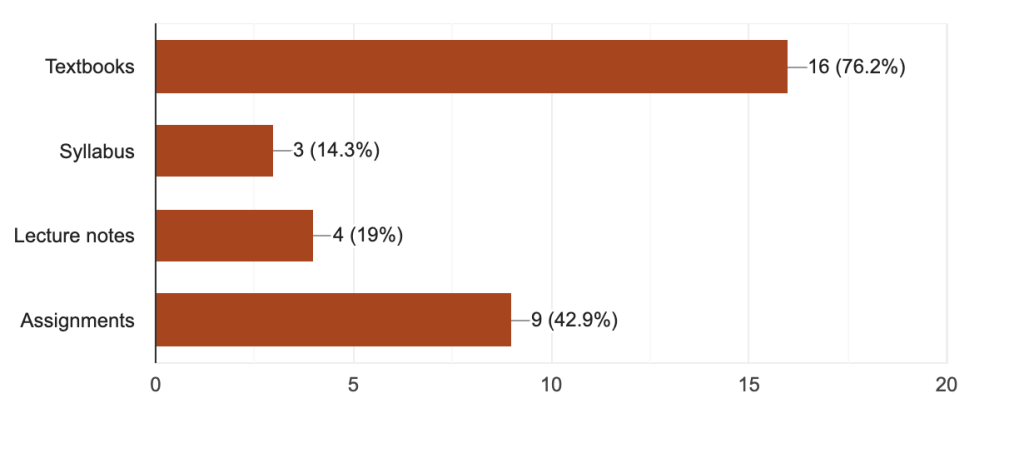The University of California, Santa Barbara (UCSB) faculty Affordable Resources for Teaching survey was deployed on February 8, 2021. The survey was open to participants until March 7, 2021. The faculty survey instrument consisted of the following 12 questions:
- What is your department?
- Have students indicated that it is difficult for them to acquire learning materials for your class? If so, can you please share some examples?
- Do you know the cost of the textbooks that you assign for your classes? If so, please share the dollar amount for the highest cost textbook. (For textbook costs, check Amazon or the UCSB Store.)
- Has the COVID-19 pandemic affected students’ access to the required resources for your classes? If so, in what ways?
- Has online teaching changed how you assign materials? If so, in what ways?
- How familiar are you with OERs? OERs are freely and openly available teaching resources. They include textbooks, lecture notes, tests, assignments, and more.
- Are you currently using OER in your course/s?
- If you are currently using OERs, please indicate which ones. (Select all that apply.)
- If you are not currently using OERs, would you consider doing so?
- If not, can you elaborate? (Select all that apply).
- If you would like to consider using OERs for your classes, how might the UCSB Library help you? (Select all that apply.)
- The library is interested in pursuing more OER adoption at UCSB. Please share your thoughts about the library’s role and any other comments you might have.
Survey Results
The survey results are located here.
The survey targeted faculty in 21 departments with 50 high enrollment courses:

The survey was sent out to all the departments at UCSB using the list for faculty communication. The survey call was communicated through the Executive Vice Chancellor’s office.
The first question asked respondents to share information pertaining to their department. The table below shows the results of the number of respondents and the departments they are associated with.
Statistics showing the number of respondents per department

Forty-six faculty from 26 departments responded to the survey. Of the 26 departments, 12 respondents were from the targeted departments of high enrollment classes. Thus, 55% or 12 departments out of the 21 targeted departments with high enrollment courses responded.
The second question was:, “Have students indicated that it is difficult for them to acquire learning materials for your class? If so, can you please share some examples?” While one faculty indicated that students had shared WiFi difficulties, 18 faculty members shared that students had indicated difficulties acquiring some of their learning materials. The COVID pandemic likely exacerbated the textbook acquisition challenges for students. Having some students sharing their textbook acquisition challenges with their faculty points to the need to communicate with faculty about adopting alternative learning resources like OER.
It is fundamental to support faculty looking to alternative teaching resources like Open Educational Resources. Commenting on OER adoption by faculty, Thus, Doug Lederman stated, “It is feasible, even logical, that the increased awareness of OER instructors developed during COVID will mean that when they have a chance to catch a breath as the pandemic slowly recedes, they will be more open to experimenting with open educational resources” (Lederman, 2021). The COVID-19 pandemic created an opportunity to initiate conversations with faculty members, especially the 18 survey respondents, to see if they have taken any measures to address the textbooks challenges shared by some of their students. This is a great moment to find out if the faculty have considered incorporating OER into their learning materials. Having such conversations will lead into discussions about open pedagogical practices the faculty might be using in their classes.
Another question on the survey was, “Do you know the cost of the textbooks that you assign for your classes? If so, please share the dollar amount for the highest cost textbook?” The responses to the question varied as indicated in the diagram below:

While most faculty are aware of the cost of the textbooks they assign to their class, gave an estimate, others indicated that there was no textbook cost incurred by their students. Only one respondent indicated that they did not know the cost of the textbook. Some of the responses highlighted faculty awareness of the textbook hardships students face. The responses given by faculty help initiate conversations with faculty on textbook cost challenges faced by students. These conversations will be one way to find out if faculty think about how textbook cost can add up when students are taking several classes. It is also a great opportunity to see if faculty have considered looking into openly licensed OER for their students.
Connected to the issue of textbook cost is the question on how COVID has impacted student access to resources and if the switch to a virtual learning environment resulted in faculty changing the way they assign learning materials. The questions asked were:
- Has the COVID-19 pandemic affected students’ access to the required resources for your classes? If so, in what ways?
- Has online teaching changed how you assign materials? If so, in what ways?
Fourteen faculty members indicated that COVID had affected student access to resources. Some faculty said the pandemic had not impacted their students while a few were not sure. Some faculty respondents indicated that resource access was very difficult for international students. Internet or technological barriers to student accessing resources was also reported by some respondents.
Due to the COVID-19 pandemic, a significant number of faculty had to change the way they assign materials. Thirty-seven or 80% of the respondents shared how they had to adjust how they assign students materials. Below is a list of select responses showing ways faculty adjusted to assigning material in a remote environment:
- Searching for resources online to replace the print materials they no longer had access to due to the library closure
- Now has students watch video clips of some of the materials they need for class
- Now assigns online resource only and increased the number of PDFs
- Switched to online 3-D images of mineral rock specimens and models
- Tried to use the “free” e-books from the library
- Assigned materials only when they can provide them digitally
- Reduced lab-based research and replaced it with more library-based research
- They no longer use course readers
- No longer assigns an exam
- Had to cut back on the number of readings
- Searched for alternative sources because they cut back some of the textbooks they used
- Used all materials from their slides and don’t require the text
- Now more careful about what they assign
The responses from faculty highlight that they have been paying attention to and are aware of changing student needs and challenges emanating from COVID-19. Having 80% of faculty paying attention to these changing student needs presents a great opportunity for the UCSB Library to start conversations with faculty surrounding OER and open pedagogy in general. There should be a follow up with the faculty respondents to start a conversation about OER options and initiatives.
Faculty were also asked the question below and were given a brief definition for OER:
How familiar are you with OERs? OERs are freely and openly available teaching resources. They include textbooks, lecture notes, tests, assignments, and more.
Below is data indicating how faculty responded to this question.
Pie chart showing how faculty are familiar with OER.

A small percentage of faculty, 12.8% responded that they were very familiar with OER. More than half of the faculty who responded indicated that they were not familiar with OER, but were interested in learning more about them. Thus, these statistics represent a need to start conversation with faculty about OER. It is a great opportunity for the library to follow up with the interested faculty and start a conversation on what OER are and how students and faculty can benefit when these open resources are incorporated into student learning.
The next question asked was, “Are you currently using OER in your course/s?” The pie chart below indicates how faculty responded.

Sixty-one percent of faculty respondents said they were not using OER but were interested in their adoption. The significant number of faculty interested in adopting OER provides an opportunity for the UCSB Library to engage faculty and see how they can be supported in adopting OER. About 21.3% of faculty indicated that they were using OER in their course or courses. The graph below shows the type of OER being used by those who have adopted them.

There is need to communicate with the faculty members who have adopted OER to assess the form of support they might need from the UCSB library. Furthermore, collaborative efforts can be forged whereby the faculty OER early adopters can help advocate the use of OER by those faculty who have not yet done so.
